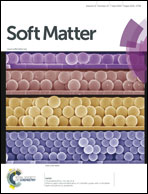Swelling and mechanical properties of hydrogels composed of binary blends of inter-linked pH-responsive microgel particles†
Abstract
We show that a new type of hydrogel can be prepared by covalently inter-linking binary blends of microgel (MG) particles and that the swelling ratio and modulus of the gels can be predicted from their composition. In previous work we established that physical gels of glycidyl methacrylate (GMA) functionalised poly(methyl methacrylate-co-methacrylic acid-co-ethyleneglycol dimethacrylate) microgel particles (GMA-MG) could be covalently inter-linked to give hydrogels, termed doubly crosslinked microgels, DX MGs. We build on this concept here by investigating the properties of DX MGs containing binary blends of GMA-MG particles and glycidyl oligo(ether ester) acrylate-functionalised microgel particles (GOE-MG). These new hydrogels were assembled by inter-linking nanoscale MG building blocks in the absence of small molecule monomers or crosslinkers. The volume fraction of GMA-MG particles used to prepare the GOE–GMA DX MGs was systematically varied. Rheology data showed that inclusion of GMA-MG and GOE-MG within the GOE–GMA DX MGs increased the modulus and yield strain, respectively, compared to the values measured for the respective physical gels. The data for the covalent GOE–GMA DX MG gels showed that the ductility increased with increasing GOE-MG content. GOE provided covalent inter-linking of the MG particles and also acted as a lubricant between particles due to its low Tg. By demonstrating compositionally determined swelling and mechanical properties for DX MG gels prepared using binary blends of MG particles, this study introduces a new, widely applicable, hydrogel construction assembly concept that is not available for conventional hydrogels.


 Please wait while we load your content...
Please wait while we load your content...